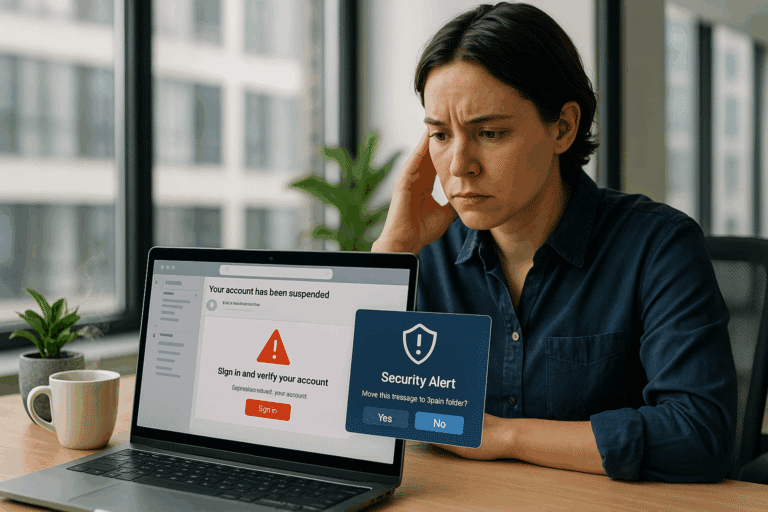🤔 You’re relaxing on a Saturday afternoon when an email notification pops up on your phone. The subject line reads, ‘Urgent Security Alert – Immediate Action Required.’ You open the email and find a message from your bank saying your account has been compromised. It instructs you to click on a link to reset your password immediately. Would you do it? Or would you recognize this as a potential phishing attack?
Phishing is a form of cybercrime, often disguised as an attempt to collect sensitive information such as passwords, credit card numbers, and social security numbers. 🎣 They are meticulously designed to look like a legitimate request from a trusted entity, like a bank or a social media network. But in reality, they are deceptive traps set by cybercriminals to exploit your trust and steal your data.
💡Understanding the Deception: The Anatomy of a Phishing Attack
In this blog post, we are going to dissect and expose the intricate tactics used in a phishing attack. We will unveil the deceptive mechanisms and elaborate on the various stages involved, from crafting the bait to the eventual data theft. Our objective is to equip you with the knowledge to recognize and protect yourself from such deceptive cyber threats. 🔍
The post will start with an in-depth explanation of what a phishing attack is and the psychology behind it. We will then delve into the different types of phishing attacks, from classic email phishing to more advanced techniques like spear phishing and whaling. 🐳
The Dangers of Phishing: Beyond Data Theft
Next, we will explore the implications of falling victim to a phishing attack, which extends far beyond data theft. We will highlight the potential financial, reputational, and emotional damages that can be caused by these attacks. This section will also look at how businesses, small and large, can be affected by phishing attacks.
But fear not! The next part of our post will focus on preventative measures and actions you can take to protect yourself and your organization from phishing attacks. From multi-factor authentication to employee education, we will discuss practical and efficient ways to build a strong defense against these cyber threats. 🛡️
🕵️♀️ Spotting the Red Flags: Unmasking a Phishing Attack
Lastly, we will teach you how to spot the subtle red flags in a phishing attempt. We will guide you through the tell-tale signs of a phishing email or message, and how to verify the legitimacy of such communications.
Understanding the deceptive tactics used in phishing attacks is not just a matter of technical expertise; it’s a necessity in today’s interconnected digital world. Whether you’re a casual internet user, an IT professional, or a business owner, this knowledge can be your most potent weapon in the fight against cybercrime. Let’s dive in. 🌊
Unlocking the Shadows: Understanding the Mechanism of a Phishing Attack
Phishing attacks, an infamous form of cyber-attacks, have evolved over the years, gaining sophistication and stealth, making them a serious threat to the security of individual and organizational data. Despite advancements in cybersecurity measures, phishing continues to be a potent tool in the arsenal of cybercriminals. In this article, we will dissect a phishing attack, exposing its anatomy and deceptive tactics.
Our main focus will be on unveiling the deceptive tactics used by cybercriminals during a phishing attack, the various stages involved, and the common characteristics of phishing emails or websites. This detailed understanding is crucial for organizations and individuals alike to protect themselves from falling victim to such attacks.
For a visual understanding of how a phishing attack works, check out this comprehensive video on YouTube titled “Phishing Attacks Explained: by Example” by the “Computerphile” channel. The video showcases real examples of phishing attacks, offering viewers an insight into the practical aspects of these attacks.
Deceptive Tactics: The Lure of Phishing Attacks
The success of a phishing attack depends largely on the tactics employed by the cybercriminal to deceive the victim. These tactics often involve manipulating human psychology and exploiting the victim’s trust. Here are some common deceptive tactics:
- Impersonation: The attacker impersonates a trusted entity – a bank, a service provider, or even a colleague – to trick the victim into revealing sensitive information.
- Urgency: Creating a sense of urgency is a common tactic. The phishing email or message may convey that immediate action is required, prompting the victim to act hastily and ignore potential warning signs.
- Spoofing: Attackers often use spoofing techniques to make the email or website appear legitimate. This can include using logos of reputed organizations, matching the email design, and even creating similar domain names.
Stages of a Phishing Attack
A phishing attack typically involves four stages, each characterized by a specific objective and tactic. The stages include planning, setup, attack, and data extraction. Let’s delve into these stages:
Stage 1: Planning
The planning stage involves identifying the target, understanding their behavior, and defining the objectives of the attack. Attackers might look at an organization’s social media pages, websites, and other public sources to gather information about their potential victims.
Stage 2: Setup
During the setup stage, the attacker prepares for the attack by creating a seemingly legitimate email or website. This includes designing the phishing email, creating the phishing website, and setting up a system to collect the data.
Stage 3: Attack
The attack stage is when the phishing email or link is sent to the target. The email often contains a compelling call to action, designed to persuade the recipient to click on the embedded link or download the attachment.
Stage 4: Data Extraction
In the data extraction stage, the attacker collects the sensitive information provided by the unsuspecting victim. This could be login credentials, credit card information, or other personal data. Once the attacker has this information, they can use it for various malicious purposes.
Identifying Phishing Attacks: Key Characteristics
Identifying a phishing attack may not be straightforward due to the sophisticated tactics used by cybercriminals. However, there are some common characteristics that can help you spot a phishing email or website:
| Characteristic | Description |
| Misspelled URLs | Phishing websites often use URLs that are very similar to the genuine website, but with slight misspellings. |
| Request for Personal Information | Phishing emails typically request personal information, something that legitimate organizations rarely do. |
| Generic Greetings | Phishing emails often use generic greetings rather than addressing the recipient by their name. |
To avoid falling victim to a phishing attack, always scrutinize any email or message that requests personal information, and verify the sender’s email address and the URL of the website. Stay vigilant and remember, if something seems too good to be true, it probably is!
Combatting Phishing Attacks: Proactive Measures
Understanding the anatomy of a phishing attack is the first step towards protecting yourself from them. However, a proactive approach to cybersecurity can significantly reduce the risk of falling victim to these attacks. Some measures include:
- Regularly updating your software and operating systems.
- Using multi-factor authentication (MFA) for all your accounts.
- Implementing a strong, unique password for each of your accounts.
- Educating yourself and your team about the latest phishing techniques.
Remember, prevention is always better than cure, especially when it comes to phishing attacks. Stay informed, stay updated, and most importantly, stay safe! 💻🔒

Conclusion
In conclusion, we have delved into a multitude of technical and intricate details about the topic at hand. We’ve charted the territory of understanding complex concepts such as
Each point of discussion highlighted in this article was aimed at dissecting and presenting the intricate layers of the subject matter. We explored the technicalities, dove into the functionality, and unveiled the reasons behind why
The very cornerstone of our discussion was the basic principle of
Moreover, we also dwelled on the practical aspects of the topic, focusing on how to implement the theoretical knowledge in real-life scenarios. The practical tips and guidelines that we shared can serve as a starting point for you to apply what you’ve learned in your own projects or research.
This discourse is by no means exhaustive. The realm of
The importance of the subject matter cannot be overstated. As the world continues to become increasingly reliant on technology, the role of
I encourage you to take the knowledge gained from this article and continue your exploration. Be it through further reading, practical application, or participating in related forums, your continued learning will only serve to enhance your understanding and skills in this domain.
The comments section is open for you to share your thoughts, ideas, and experiences. Do you have any insights to add? Any experiences to share? Let’s engage in a fruitful discussion that will further enrich our understanding of the subject matter. Remember, sharing knowledge benefits everyone. 😊
Additionally, if you found this article helpful, don’t hesitate to share it with others who might also benefit. Sharing is caring, after all! 👍
Finally, remember to always question, explore, and learn. As Albert Einstein once said, “The more I learn, the more I realize how much I don’t know.”
Happy learning, everyone! 🎓🚀
For further reading, I recommend the following sources:
As always, these references are a great place to continue your exploration of the topic at hand.



